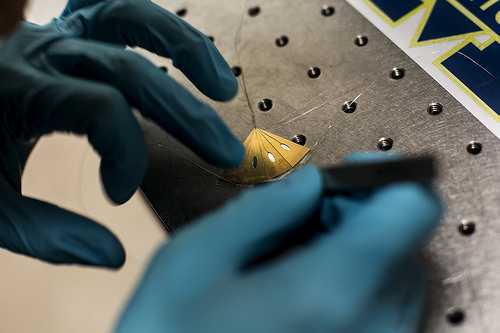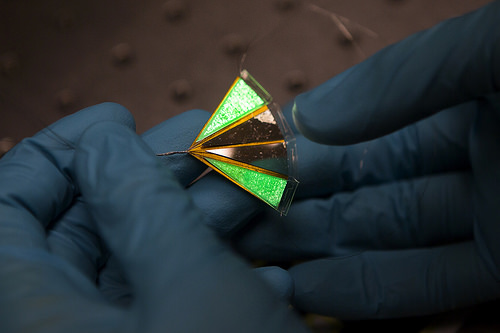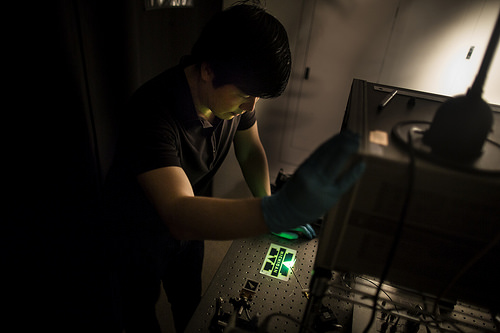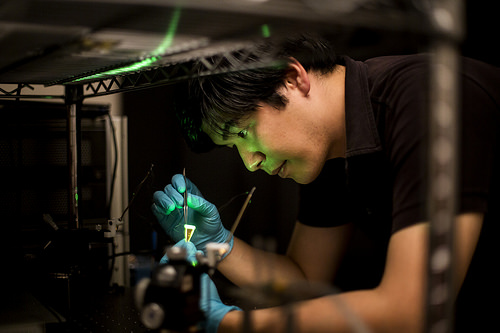The most common kind of light bulb in the United States—the incandescent—is only about 5 percent efficient. The phosphorescent organic light-emitting diode, on the other hand, makes light out of 100 percent of the electricity that goes into it.
They're good for smartphone screens and mood lighting, but they drop off in both efficiency and lifetime when they have to shine brightly.
University of Michigan researchers have found an elegant way to get around this problem—by arranging the PHOLEDs into a pyramid.
 |
 |
|
Jaesang Lee, Electrical Engineering PhD Student and member of the Stephen Forrest's Optoelectronic Components and Materials Laboratory, constructs a light concentrating LED in the EECS Building on May 29, 2014. 9Photo: Joseph Xu, Michigan Engineering Communications & Marketing) |
"Achieving extra brightness from the conventional, flat design is inefficient and shortens the device lifetime," said Jaesang Lee, a doctoral student in electrical engineering and computer science and first author of the study. "However if we integrate our PHOLEDs into a pyramidal shape, we are able to achieve the equivalent, concentrated brightness at a much lower electrical current."
Because of their high efficiencies, PHOLEDs already claim much of the smartphone display market, and they are edging into televisions and ambient lighting. But when it comes to illuminating tasks like reading and detailed work, they face a disadvantage: their efficiencies and life expectancies drop off sharply when they have to shine very brightly. This happens because the easiest way to make an LED brighter is to drive it with a higher current, and this is hard on organic LEDs.
The new device demonstrates a slick solution to the problem. Because PHOLEDs are naturally reflective, they serve a dual purpose when arranged on the inner surfaces of a pyramid-like structure. The PHOLEDs emit and concentrate the light that emerged from the opening at the base of the pyramid.
Although the surface area emitting light was more than four times larger than the opening at the base of the pyramid, this setup consumed about three times less electricity than trying to run a square PHOLED the size of the base at equal brightness.
The concentrator also achieves a better light distribution than a simple panel, evenly lighting flat surfaces rather than producing a bright spot in the center that dims toward the edge of the lighted area.
 |
 |
|
Jaesang Lee tests a light concentrating LED which are able to both generate and emit light through its pyramidal shape, enabling for efficient energy use. (Photo: Joseph Xu, Michigan Engineering Communications & Marketing) |
"My hope is that OLEDs will deeply penetrate all aspects of the lighting market because they're very efficient, very attractive and as people accept them, it will take a load off the electricity grid," said Stephen Forrest, the William Gould Dow Collegiate Professor in Electrical Engineering and leader of the study.
He says that about 30 percent of U.S. electrical usage goes to lighting, with 80 percent of that energy consumed by incandescent bulbs.
Lee's pyramidal structure resulted in illumination three times brighter than a flat configuration at the same current could have offered. Forrest thinks that smoothing out the edges and points of the pyramid into a shape more akin to a champagne flute could lead to even higher light concentrations, seven or even 10 times the brightness of a flat fixture.
An additional challenge for PHOLEDs is that some of the light gets converted to heat before it can get out of the device. As a result, laboratory PHOLEDs are about four times more efficient than incandescents but they could be 10 times more efficient. Forrest's team is also working on improving light output.
The paper, titled "Electrophosphorescent organic light emitting concentrator," will be published in Light: Science and Applications.















